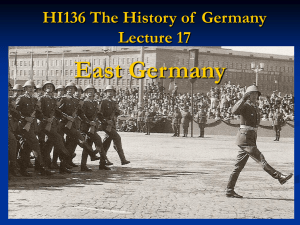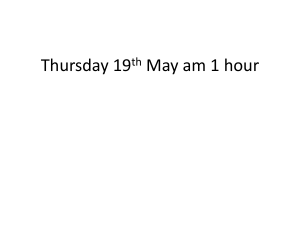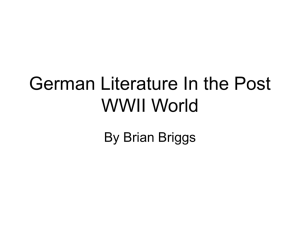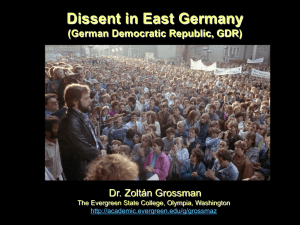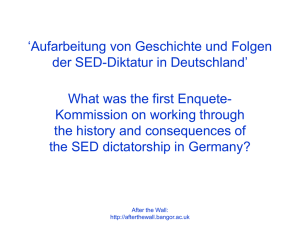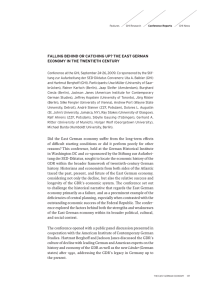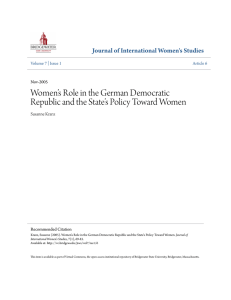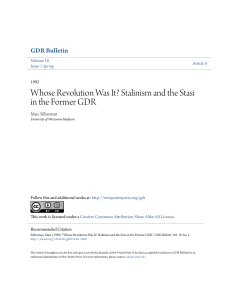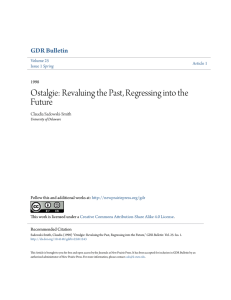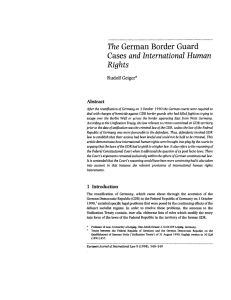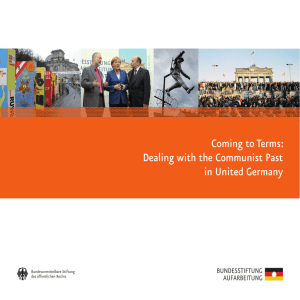East Germany: The Anti-fascist State HI290- History of Germany
advertisement
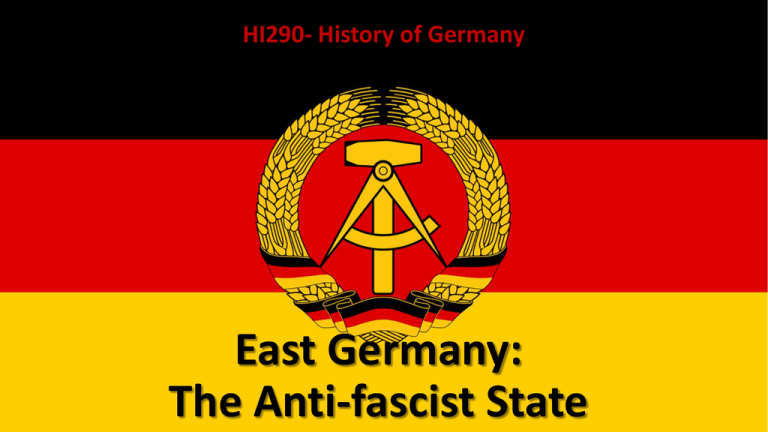
HI290- History of Germany East Germany: The Anti-fascist State Organisation of the East German State 16 Members 9 Candidates (Executive/Collective Head of State) Chairman, 6 Deputy Chairmen, Secretary, 16 Members. (Government) Led by an 11-man Presidium; makes decisions in consultation with Central Committee of the SED. Chooses Every 5 years Appoints Responsible for national security; comprised of Chairman and 12 members drawn from the Politburo of the SED. Chooses Every 5 years Chooses 135 Members 46 Candidates Chooses (Every 5 years) CDU 52 LDPD 52 DBD 52 (500 seats in total) NDPD SED FDGB 52 127 68 FDJ 40 DFD 35 KB 22 Send Delegates to 15 Regional Party Organisations Send Delegates to 250 Local Party Organisations State apparatus Party apparatus Administrative districts of the GDR, 1952 The Sozialistische Einheitspartei Deutschlands (Socialist Unity Party, SED) Wilhelm Pieck (KPD) shakes hands with Otto Grotewohl (SPD) on formation of SED, April 1946. The Police State Emblem of the Ministerium für Staatssicherheit (MfS, Ministry of State Security or Stasi) The East German Volkspolizei on parade, 1955 Erich Mielke (1907-2000), head of the MfS, 1957-1989. The Economy • 1945-46: Wide-ranging land reform, expropriation of businesses and nationalization of key industries: 40% of industry under state control; 100 hectares (247 acres) of land redistributed to peasants and refugees. • GDR at an economic disadvantage compared to the West – had only 30% of industrial capacity, few natural resources and a smaller population. • Planned economy focusing on building up heavy industry at the expense of essentials and consumer goods – meat, butter and sugar rationed until 1958, luxury goods like chocolate almost unobtainable. • Growth fell from 8% in 1950 to 2.3% between 1960 & 1962. Walter Ulbricht (1893-1973) • Born in Leipzig, joined the Spartacist League in 1918. • Co-founder of the KPD, elected as a Reichstag Deputy in 1928. • 1933-45: In exile in the USSR. • 1949: Appointed Deputy Prime Minister of the GDR. • 1950: Became General Secretary of the SED. • 1960: Became Chairman of the Council of State. • Favoured ‘hard line’ of constructing socialism in half a country rather than pursuing reunification; in 1953 under heavy fire from Politburo colleagues, but ‘saved’ by 17 June uprising. • 1960s: Limited economic reforms, but unable to change with the times. • 1971: Ousted by ‘palace coup’ by Honecker, with Soviet backing. June 1953 Uprising Anti-Fascism • Marxist-Leninist doctrine always interpreted fascism as an outgrowth of capitalism; therefore antifascism linked to anti-capitalism (big business as Hitler’s stringpullers). • Fascism also interpreted as a political class war (mainly v. KPD), rather than racial war (v. Jews); GDR paid no reparations to Israel and anti-Semitic attacks on graveyards persisted. • West German Federal Republic viewed as haven of former Nazis, protected by Anglo-Americans (especially in 1950s/60s); antifascism thus had contemporaneous function of anti-westernism (e.g. Berlin Wall officially labelled ‘Antifascist Defence Rampart’). • SED leadership (mainly Soviet exiles) had ambivalent attitude to ‘real’ antifascist veterans (marginalised ‘inland’ resisters, dissolved veterans’ organisations). • Antifascism an affective moral argument for wartime generation; but younger generations increasingly indifferent to abstract antifascism. Buchenwald memorial: unveiled in 1958, this group represents the KPD’s leading role in the resistance, with a (historically dubious) myth of the camp’s self-liberation. Buchenwald was the GDR’s main memorial site for school visits and veterans meetings. Republikflucht A Family Flees from East to West over the Border in the Bavarian Forest (1948-49) Troops of the 40,000-strong Grenztruppen der DDR (East German Border Guards) patrolling the innerGerman border, 1971. Education, Culture and the Arts Foundation of the FDJ in Berlin, Nov. 1947 Bertolt Brecht (1898-1956) Christa Wolf (1929-2011) Interpretations Totalitarian Interpretations • Popular in 1950s West German interpretations; revival post-1989 • Comparisons drawn with brown dictatorship of National Socialism • Stress illegitimacy of Soviet occupation & East German ‘puppets’ • State ideology of ‘socialist personality’ within collective • ‘Leading role’ of ruling party enshrined in constitution • Stasi secret police • State control of economy • Control of media • Control of economy • Berlin Wall as epitome of state control of individual • Breached UN human rights on freedom of travel • Also popular with many former GDR citizens; but is this because it denies personal responsibility? A Modernising Dictatorship? • Complex industrial economy required ‘rational’ not ‘ideological’ elite • More university graduates enter party apparatus from 1960s • Peter C. Ludz, The Changing Party Elite in East Germany (1968/72) • Economic reforms of 1960s (New Economic System) • Attempt at decentralisation and incentivisation of economy • Technological revolution • Special role of intelligentsia in GDR (see dividers on state emblem) • Precision engineering from Dresden & Leipzig • 1980s gamble on microchip technology (too high investment costs) • Welfare dictatorship (Konrad Jarausch) • Indirect use of ‘social power’ to predispose groups to choose socialism • Full employment, hospitals, education system > fond memories • Educational dictatorship (Erziehungsdiktatur)? • Party ‘in loco parentis’, knowing what was good for the people • Rolf Henrich, The Guardian State (1989); party man turned dissident
